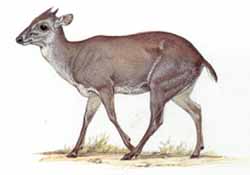English: Blue Duiker; French: Céphalophe bleu; Afrikaans: Blouduiker; Bila: Buluku; Duala: Isedu; Gbaya: todo, tò’dò; Ici-Taabwa: Mpelele; Kikuyu: Ihiiya; Kikongo: Nsiesi; Kiladi: Nciesie; Kiswahili: Paa; Lomongo: Mboloko; Maasai: erong’o; Manza: Dèngbè; Punu: Tsie-tsie; Sango: dèngbè; Shaba: Kabuluhu; Shangan: pithi; Shona: Ndungu, Ndundu; Teke: Sen; Zulu: Spitu
 |
Former distribution: As now.
Present distribution: From south-eastern Nigeria east to southern Sudan, southern parts of Uganda, south-western and south-eastern parts of Kenya, in Tanzania around Lake Victoria, Zaire, Congo, Cabinda, northern and central Angola, Gabon, Fernando Póo (Malabo), northern and eastern Zambia, Malawi and central Mozambique and Cape Province in South Africa.
Behaviour: See Rotflankenducker
Population status: Rare.
Brief notes:
Body weight: 8-10 kg
Head and body length: 70-90 cm
Tail length: 10-13 cm
Shoulder height: 35-40 cm
Gestation period: 4 months
Maximum age: 10 years
Trophy: Record SCI: 8 3/4 score, 1982 Zambia, DON L. CORLEY; average 4 score. RW’s: 4 3/4″, Fernando Póo, C. MATTHEWS; 3 7/8″, 1924 Kenya, Bern Museum (de Watteville); average 1 3/4″.
Hunting methods: With beaters, dogs and nets.
Subspecies: 16. The classifications are not clear; HALTENORTH, TRENSE describe 18 (1956), ANSELL 16 (1972). A revision is needed.
Remarks: The list of subspecies recognized by ANSELL (1972) is as follows: C.m. fusicolor, C.m. hecki, C.m. defriesi, C.m. lugens, C.m. schusteri, C.m. sundevalli, C.m. pembae, C.m. musculoides, C.m. aequatorialis, C.m. anchietae, C.m. simpsoni, C.m. congicus, C.m. schultzei, C.m. melanorheus.






